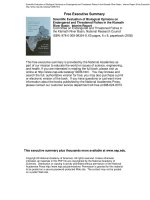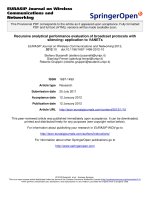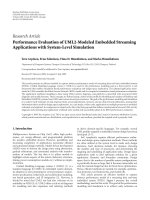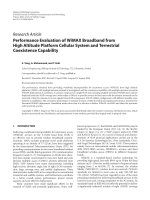Performance evaluation of personalized ventilation personalized exhaust (PV PE) system in air conditioned healthcare settings 1
Bạn đang xem bản rút gọn của tài liệu. Xem và tải ngay bản đầy đủ của tài liệu tại đây (246.75 KB, 19 trang )
PERFORMANCE EVALUATION OF
PERSONALIZED VENTILATION -
PERSONALIZED EXHAUST (PV-PE) SYSTEM IN
AIR-CONDITIONED HEALTHCARE SETTINGS
YANG JUNJING
(Bachelor of Eng., Tongji University;
Master of Science, University of Reading)
A THESIS SUBMITTED
FOR THE DEGREE OF DOCTOR OF PHILOSOPHY
DEPARTMENT OF BUILDING
NATIONAL UNIVERSITY OF SINGAPORE
2013
i
Declaration
ii
Acknowledgements
I would like to acknowledge and extend my heartfelt gratitude to the following
individuals who have made the completion of this thesis possible.
Firstly I would like to express my deepest acknowledgement to my supervisor
Professor S.C. Sekhar for his vital guidance, constant support, valuable advice
and encouragement. He was also very accommodating in allowing me
freedom to pursue my interests which were out of my research scope. I feel
lucky to have been one of his PhD students.
I am also grateful to my thesis committee members: A/P Cheong Kok Wai,
David, and A/P Benny Raphael, whose doors are always open, for freely
sharing with me their valuable knowledge, experience and expertise on any
issues related to my research.
I would like to thank Professor A.K. Melikov from DTU for his suggestions
and comments for the Qulify Exam Report of my PhD study which gives me
ideas for experimental design.
I want to thank Ms.Wu Wei Yi, Mr Zaini bin Wahid, Mr. Tan Cheow Beng,
Mr. Tan Seng Tee for assisting with the laboratory equipment and instruments
during the experiments in my research.
I am grateful to Dr. Jovan Pantelic and Dr. Wang Junhong for sharing their
knowledge about CFD simulation. I also wish to thank Dr. Li Ruixin and
Huang Shuguang for sharing their experience during the experiments.
Gratitude goes out to the National University of Singapore for funding this
effort and providing much needed apparatus during the course of this thesis.
iii
Lastly, I would like to express my sincere gratitude to my husband, my
daughter and my parents for their understanding, support and unconditional
love.
Singapore, Final submission May 2014
Yang Junjing
iv
Contents'
Word did not find any entries for your table of contents.
In your document, select the words to include in the table of contents, and then
on the Home tab, under Styles, click a heading style. Repeat for each heading
that you want to include, and then insert the table of contents in your
document. To manually create a table of contents, on the Document Elements
tab, under Table of Contents, point to a style and then click the down arrow
button. Click one of the styles under Manual Table of Contents, and then type
the entries manually.
v
Summary
Severe Acute Respiratory Syndrome, H1N1 and other flu-related outbreaks in
recent times have highlighted the issue of short-range aerosol transmission
between healthcare workers and the patients. Concerns about the ventilation
system design in healthcare centres in the field of control of airborne
transmission of infection have become topical and important. Personalized
Ventilation (PV) has been introduced in indoor air distribution for more than a
decade and the concept involves delivering 100% conditioned outdoor air
directly to the occupant breathing zone. The primary aim of a PV system is to
supply fresh air to the breathing zone to enhance Inhaled Air Quality. At the
same time, it can also be seen as a solution to prevent the spread of
contaminated air. Whilst a conventional PV system would fulfil most of these
requirements, it may not be able to adequately prevent the spread of
contaminated air as the PV air would go past an infected person and mix with
the room air. In order to maximize the advantages of a PV system in
delivering personalized air to the breathing zone, it is interesting to explore the
use of a personalized exhaust (PE) device that is integrated with the chair and
assists in pulling the PV air flow towards the seated person. Not only is the
inhaled air quality improved further but the exhaled contaminated air is
extracted locally and its spread into the room air is minimized by adding the
local exhaust working together with the PV system. Experimental study using
two types of tracer gases have been conducted to evaluate the performance of
this novel PV-PE system in conjunction with two different background
ventilation systems. Two types of PE: top-PE and shoulder-PE are evaluated
and four different arrangements between the Healthy Person and the Infected
Person were studied. Three indices: Personalized Exposure Effectiveness;
Intake Fraction; and Exposure Reduction were used to evaluate the system.
The main hypothesis is that the Top-PE is better than Shoulder-PE and in the
presence of PE for patient, Displacement Ventilation system leads to a better
exposure reduction than Mixing Ventilation system.
vi
The results indicate that there is a good potential for improving inhaled air
quality by having the combined PV-PE system to pull the clean air towards the
seated person, especially under displacement ventilation. When the PE is set at
10 l/s, the PEE of 5 l/s PV and 10 l/s PV are 27% and 50% higher with DV
than MV at the nearest position (0.2 m and 0 degree) respectively. It is also
seen that this kind of personalized exhaust can prevent the spread of
contaminated air by exhausting the exhaled air directly before it mixes with
the room air; especially the top-PE has a better performance than shoulder-PE.
Furthermore, the use of PE is a more efficient way to protect the healthy
person than using PV. After using the top-PE for infected manikin while
switching off the PV for healthy manikin, a more than 70% reduction of
exposure is found under MV and more than 75% for DV. However, the
Healthy Manikin only enjoys about 25% reduction in exposure to the Infected
manikin exhaled contaminated air when PV fresh air is at 5 l/s, and 55% if the
PV flow rate is increased to 10 l/s. This thesis contributes to the knowledge of
ventilation systems by addressing a few limitations of PV systems as well as
controlling the short range aerosol transmission between healthcare workers
and patients in healthcare settings.
vii
List of Tables
No table of figures entries found.
In your document, select the words to include in the table
of contents, and then on the Home tab, under Styles, click
a heading style. Repeat for each heading that you want to
include, and then insert the table of contents in your
document. To manually create a table of contents, on the
Document Elements tab, under Table of Contents, point to
a style and then click the down arrow button. Click one of
the styles under Manual Table of Contents, and then type
the entries manually.
List of Figures
No table of figures entries found.
In your document, select the words to include in the table
of contents, and then on the Home tab, under Styles, click
a heading style. Repeat for each heading that you want to
include, and then insert the table of contents in your
document. To manually create a table of contents, on the
Document Elements tab, under Table of Contents, point to
a style and then click the down arrow button. Click one of
viii
the styles under Manual Table of Contents, and then type
the entries manually.
Nomenclature
Abbreviations
ACE Air Change Effectiveness
ACH Air Change Rate
AHU Air Handling Units
ASHRAE American Society of Heating, Refrigerating and Air-
Conditioning
AQI Air-Quality Index
ATD Air Terminal Device
BTM Breathing Thermal Manikin
CFD Computational Fluid Dynamic
CMP Computer Monitor Panel
CPP Circular Perforated Panel
CSP Computer Simulated Person
CTM Computational Thermal Manikin
CV Central Ventilation
DDV Desk Displacement Ventilation
ix
DPV Desktop Personalized Ventilation
DR Draught Rating
DV Displacement Ventilation
FCU Fan Coil Unit
HBIVCU Hospital Bed Integrated Ventilation and Cleaning Unit
HDG Horizontal Desk Grill
HEPA High-Efficiency Particulate Air
HP Healthy Person
HVAC Heating Ventilation and Air Conditioning
IAQ Inhaled Air Quality
ICAS Infection Control at Source
iF Intake Fraction
IP Infected Person
ISO International Organization for Standardization
LEV Local Exhaust Ventilation
MV Mixing Ventilation
PE Personalized Exhaust
PEE Personal Exposure Effectiveness
PEI Personal Exposure Index
PER Pollutant Exposure Reduction Efficiency
PEM Personal Environment Module
PRE Pollutant Removal Efficiency
PV Personalized Ventilation
RH Relative Humidity
RMP Round Movable Panel
RNG Re-Normalisation Group
SARS Severe Acute Respiratory Syndrome
SBS Sick Building Syndrome
SHPV Seat Headrest Personalized Ventilation
SIMPLE Semi-Implicit Method for Pressure-Linked Equations
TAC Task-Ambient Conditioning
TAM Task Air Module
x
TV Total Volume Ventilation
UFAD Under Floor Air Distribution
VDG Vertical desk grill
Symbols
Δt Temperature Difference
C Constant dependent on clothing, body posture, chamber
characteristicsand thermal resistance offset of the skin surface
temperature control system (K.m
2
/W)
C∞ Contaminant concentration in the outdoor supply air (ppm)
C
I
Contaminant concentration in the inhaled air of a person (ppm)
C
PV
Concentration of the tracer gas in personalized air (ppm)
C
R
Contaminant concentration in the exhaust/return air (ppm)
Tracer gas concentration of ambient air
C
h
Inhaled tracer gas concentration for the Healthy Manikin
C
i
Exhaled tracer gas concentration from the Infected Manikin
C
pvpe off
Tracer gas (N
2
O) concentration in the inhaled air of the Healthy
Person when both the PV and PE are turned off
a
C
xi
C
on
Tracer gas (N
2
O) concentration with the particular PV or PE or
both turned on
D Hydraulic diameter (m)
I Turbulence intensity (%)
k Turbulent kinetic energy (m
2
/s
2
)
L Flow rate(l/s)
Mp Mass flow rates of inhalation for the healthy manikin (kg/s)
MI Mass flow rate of exhalation for the infected manikin (kg/s)
Qt Dry heat loss
T Temperature (°C)
V
F,L
Fresh air volume (l)
Inhaled air volume (l)
t*
eq
Manikin-based equivalent temperature in reference conditions (°C)
t
0
Supply air temperature (°C)
t
eq
Manikin-based equivalent temperature in an actual environment
(°C)
ɛ Turbulent kinetic energy dissipation rate (m
2
/s
3
)
ɛ
p
Personal exposure effectiveness (dimensionless)
ɛ
e
Personal exposure index (dimensionless)
η
PER
Pollutant exposure reduction efficiency (%)
Φ Diameter
τ Reynolds stress (kg/m/s
2
)
τ Return age of the return/exhaust air(s)
τ
bl
Average age of air at the breathing level(s)
y+ Near wall distance unit (dimensionless)
L
V
xii
13
Chapter 1: Introduction
1.1 Background and motivation
With Several Severe Acute Respiratory Syndrome outbreaks, SARS in 2003,
Pandemic Influenza A (H1N1/2009), and the more recent Influenza A (H5N1) in
2010, concerns about the airborne transmission of infection have become important.
During the epidemics of Severe Acute Respiratory Syndrome (SARS) in China, 917
out of 4698 infected person were hospital/healthcare workers; this has highlighted the
issue of short range aerosol transmission between healthcare workers and the patients.
Li et al. (2007) reviewed the evidence for the effects of ventilation on the
transmission of infectious diseases. They concluded that there was good evidence (as
demonstrated by the contemporary technology available at the time of the studies) for
aerosol transmission influenced by ventilation factors in outbreaks involving measles,
chickenpox, the pneumococcus (Streptococcus pneumonia), SARS-CoV, tuberculosis,
influenza and smallpox. Therefore, ventilation systems in healthcare environments
should be carefully designed to reduce the risk of aerosol transmission, in particular
those causing respiratory and gastrointestinal infection.
Mixing ventilation, displacement ventilation and under-floor air distribution (UFAD)
are at present the methods most applied in mechanically ventilated healthcare centers.
Mixing ventilation involves mixing of the high momentum supply air with room air
completely so that the temperature is uniform either in the entire space or in a specific
zone of the space. It is able to provide uniform air quality in rooms and relatively
great freedom in terms of interior decoration. However, the supply air at a low
contaminant concentration is mixed with the contaminated room air by the time it
reaches the inhalation zone of the healthy person. Displacement ventilation involves
the supply of cool air at a low velocity through air inlets that are installed in the lower
portion of the room, at the wall or floor. While it has been shown to provide
occupants with better air quality and has good energy saving potential, the risk of
drafts and contaminant issues have been raised. Another ventilation approach is the
under-floor air distribution (UFAD) concept. The basic idea of the UFAD system is to
supply air through a pressurized plenum to the occupants’ area. UFAD has the
potential to increase the flexibility of space subdivision and reduce the zone sensible
14
load by not conditioning the upper part of the zone (Eng., 2009). However, despite all
the advantages of UFAD, there are some disadvantages, such as cold feet and draft
discomfort. Under UFAD, mixing ventilation and displacement ventilation systems,
the fresh air cannot be delivered into the occupants’ breathing zone. Hence, the
personalized ventilation concept was introduced in indoor air distribution more than a
decade ago. It supplies clean, cool and dry outdoor air at low turbulence directly to
the breathing zone of occupants. Different types of PV air terminal devices have been
developed and their performance evaluated. The ability to provide local cooling and
thereby enhance thermal comfort as well as improve inhaled air quality has been
examined together with different types of background ventilation systems. It has been
demonstrated that PV system is able to improve indoor air quality and potentially
increase occupants’ satisfaction (Melikov et al, 2002; Kaczmarczyk et al., 2004;
Sekhar et al, 2005; Gong et al, 2006; Yang et al, 2010a; Li et al, 2010).
Despite all the advantages of PV, there are some disadvantages. The PV ATDs are
typically either fixed in a place or have little flexibility to rotate and move. However,
the inhaled air quality and thermal sensation depend on the distance between PV ATD
and human being. Once the occupant starts moving around the desk, the distribution
of personalized air cannot change accordingly. Although personal control was
introduced to allow occupants to change the flow rate according to their preference,
the angles and direction could not be manually adjusted easily, especially for some
ATD such as vertical desk grille (VDG).
In order to maximize the advantages of a PV system in delivering personalized air to
the breathing zone at all times, it is interesting to explore the use of a localized
exhaust device that is integrated with the chair and assists in pulling the PV air flow
always towards the chair i.e. the seated person. Thus, in the case of a seated person
moving within certain limits around the workstation, the chair integrated localized
exhaust device will serve to provide directional control for the PV air plume. A
certain minimum gauge pressure of the localized exhaust system is necessary to be
able to divert the personalized air within the range of movement of the seated person.
And most importantly, in the context of airborne infection control, it is critical that the
ventilation system is able to extract the contaminated exhaled air immediately and
15
within the shortest possible time. This will minimize the spread of the contaminated
air into the room air. Studies have found that normal breathing can produce respirable
contaminated droplets (Edwards et al., 2004). Gao et al. (2008) found that PV has the
possibility to increase the intake fraction of exhaled air and droplets from other
occupants. In order to prevent or minimize the spread of contaminated air exhaled by
occupants efficiently, the ideal strategy is to exhaust the exhaled air as much as
possible right around the infected person. Local Exhaust Ventilation (LEV) is not a
new concept, it is a system that uses extract ventilation to prevent or reduce the level
of airborne hazardous substances from being breathed by people in the workplace,
which has been used in industry for many years. The pollutants are drawn away from
the source so that the hazardous substances are less likely to be inhaled by working
people. The LEV has been reported with good performance of protecting workers in
some industry by extracting air and discharging the air into the atmosphere,
sometimes having it cleaned first to make it safe for release. However, limited studies
have considered LEV as a ventilation type to reduce the transmission of infectious air
in indoor rooms and spaces, such as wards in hospitals and air planes (Kwan et al.
2008; Melikov et al. 2010; Dygert & Dang, 2010, 2011; Zítek et al. 2010). So far no
study has evaluated the combination of PV and LEV in healthcare settings.
In the field of ventilation design in healthcare centers and hospitals, a lot of studies
have been conducted to minimize both the short-range and long-range airborne
infection routes (Cheong & Phua, 2006; Qian et al. 2008; Ho et al., 2009; Balocco &
Lio, 2011; Nielsen et al., 2010;Villafruela et al., 2013). However, most healthcare
ventilation system studies focus on specialized areas such as ward, operating rooms
and isolation rooms. In real situations, a normal consultation room is the first place an
infected person would stay before he/she will be diagnosed as infected and kept in an
isolation room. Thus, the consultation procedure and simple check-up procedure in
the consultation room may pose a risk of transmission of infectious diseases. The
movement of the airborne particles and contaminated exhaled air around a person is
partly governed by that person’s ‘microenvironment’ and partly by the airflow around
the microenvironment. The idea of a novel PV-PE system aiming to create a
microclimate helping to prevent the spread of exhaled contaminated air is supported
by this observation.
16
1.2 Research Objectives
This study aims at exploring the two types of newly-developed local exhaust
devices, ― top-PE and shoulder-PE, which work together with PV to provide a
Healthy Person with conditioned outdoor air for enhanced thermal comfort and
inhaled air quality, and minimizing the contaminated exhaled air as well as small
droplets from spreading into the room in healthcare settings.
The objectives are stated as follows:
1 Evaluate the potential of a PE device to enhance the performance of a PV device in
terms of pulling the PV conditioned outdoor air towards a Healthy Person.
2 Determine the effectiveness of airborne infection control of the combined PV-PE
system in conjunction with background MV or DV systems in terms of the localized
extraction of the contaminated exhaled air from an Infected Person in healthcare
settings
2a Infected Person seated facing the seated Healthy Person
2b Infected Person seated under two different configurations by the side of the seated
Healthy Person
2c Healthy Person standing by the side of the seated Infected Person
3 Evaluate the potential for energy savings using the most optimal PV-PE
configuration from objectives 1 and 2
1.3 Structure of Thesis
This study is in the field of ventilation but results from this study have application on
control of airborne infection disease transmission in healthcare centres and hospitals.
The structure of the thesis in each chapter is described briefly as follows:
Chapter One introduces the background of the recent awareness of the effect of
ventilation on airborne infection control and different types of conventional
mechanical ventilation systems, and the motivation of the study.
17
Chapter Two is the literature review. This study is not independent of, but based on,
previous research on PV system, local exhaust system in the field of reducing the
transmission of infectious air in indoor environments, ventilation in healthcare centers
and hospitals. After summarizing in detail the three topics, knowledge gap will be
identified which give a general overview towards the motivation of this study.
Chapter Three states the research methodology. It consists of three different sets of
experiments and the details of how the experiments are designed, the types of
instruments used, the experimental conditions and test procedures, data collection
method.
Chapter Four describes the preliminary study. The preliminary study comprised two
pilot studies, which were conducted with a few parametric variations to find ways to
make the experimental set-up more optimal.
Chapter Five describes the influence of combined PV-PE for a Healthy Person on the
ability to change the profile of PV conditioned outdoor air when the person is moving
around his/her desk while remain seated. The influence of distance between PV ATD
and seated person and the angle between the PV ATD centre line the breathing zone
were studied.
Chapter Six (and Appendix 1 and 2) documents the potential protection of a
Healthy Person (HP) from exhaled contaminated air from an Infected Manikin
(Infected Person) by using a PE for Infected Person (IP) and PV-PE for the Healthy
Person. A normal consultation procedure in healthcare settings with one IP sitting
facing the HP was studied under Mixing Ventilation and Displacement Ventilation.
The exposure of the Healthy Person was studied with two types of PE with two
different flow rates.
Chapter Seven documents the potential protection of a Healthy Person from exhaled
contaminated air from an Infected Manikin (Infected Person) by only using a PE for
Infected Person with either Mixing Ventilation or Displacement Ventilation system.
Three different position arrangements with closer distance between the Healthy
Person and the Infected Person were considered to simulate the simple sampling or
medical check-up procedure. The exposure of the Healthy Person was compared
18
between the three arrangements with and without PE. The exposure was also recorded
with two types of PE with two different flow rates.
Chapter Eight describes simulations of the Indoor Environmental Chamber using
CFD. Model was first validated by comparing the results from CFD and the
experiments. More flow rates are investigated using CFD simulation to evaluate the
potential for energy savings using the most optimal PV-PE configuration from
experiments.
Chapter Nine contains the conclusions and recommendations. The objectives are
reviewed and the hypotheses are verified. Limitations of this study are stated and
practical implementation of the novel PV-PE system is discussed. In particular, the
contributions of this research are briefly discussed. Lastly, some suggestions for
further research and the development of ventilation system for PV-PE system and
airborne infection transmission control are given.
!









